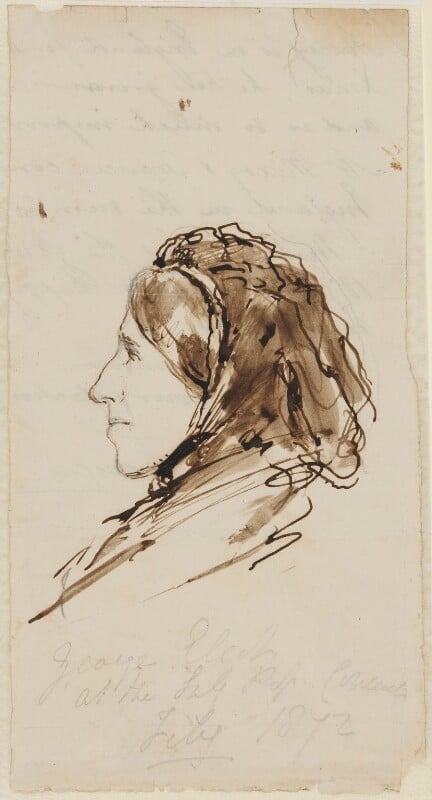Hi all! George Eliot is running in 2023/4. Please email me if you have any questions or concerns.
Convenor - Dr Michael Meeuwis
George Eliot’s many readers know of her interest in presenting something like a vision of a society: an account of how individuals function within a wider social pattern, figured variously as a web or a labyrinth. This module offers the opportunity for a slow reading of all of Eliot's major fiction.In a different academic era, we'd call this something like "George Eliot's vision of a society." In our current moment, I'm interested in how nineteenth-century literature invented our categories of social analysis—and indeed how nineteenth-century literature might give us new, or at least still-useful, ideas for doing so. I'm also interested in how George Eliot fits into our understanding of the contemporary Midlands.
Our focus throughout is going to be
Assessment:
Intermediate Year:
100% assessed (2 x 3500-word essay)
Final Year:
100% assessed (2 x 4000-word essay)
Essays are independent research projects developed in consultation your module tutor.
|
17. Outline Syllabus
Term One:
|
Week
|
Primary Text
|
Secondary Reading
|
|
1:
|
Nancy Henry, ed., The Cambridge Companion to George Eliot (all essays, but our focus will be on the Levine introduction)
George Eliot, "Amos Barton," from Scenes of Clerical Life
|
|
|
2:
|
Adam Bede
|
Strauss, The Life of Jesus, trans. George Eliot (Byatt and Warren 447-458)
|
|
3:
|
Adam Bede
|
Herbert, Christopher. “Preachers and the Schemes of Nature in Adam Bede.” Nineteenth-Century Fiction 29.4 (March 1975): 412–427. |
|
4:
|
Adam Bede
|
Horowitz, Evan. “George Eliot: The Conservative.” Victorian Studies 49.1 (Autumn
|
|
5:
|
The Mill on the Floss
|
David Caroll, "Introduction: a working hypothesis"; optional, "The Mill on the Floss: growing up in St Ogg's"
|
|
7:
|
The Mill on the Floss
|
Nicholas Dames, "Mass Reading and Physiological Novel Theory" (optional: "Melodies for the Forgetful: Eliot, Wagner, and Duration") |
|
8:
|
The Mill on the Floss
|
Sally Shuttleworth, "Natural History as Social Vision," |
|
9:
|
Silas Marner
|
Rae Greiner, "Not Getting to Know You: Sympathetic Detachment" and optional "Introduction: Thinking of You Thinking of Me"
Jaffe, Audrey, Scenes of Sympathy
|
|
10:
|
Silas Marner
|
George Levine, "Introduction," The Cambridge Companion to George Eliot (2d end) |
Term Two:
|
Week
|
Primary
|
Secondary Reading
|
|
1:
|
Romola, introduction and chapters 1-3
|
|
|
2:
|
Felix Holt
|
Peter Brooks, "George Eliot's Delicate Vessels," in Realist Vision
Hollis, Hilda. “Felix Holt: Independent Spokesman or Eliot’s Mouthpiece?” ELH 68.1 (Spring 2001): 155–177.
|
|
3:
|
Felix Holt
|
Jaffe, Audrey, "Introduction" (1-26) and "Consenting to the Fact" (121-58) in Scenes of Sympathy |
|
4:
|
Middlemarch
|
Gillian Beer, Darwin's Plots, "George Eliot: Middlemarch"
|
|
5:
|
Middlemarch
|
J. Hillis Miller, “Optic and Semiotic in Middlemarch.” In The Worlds of Victorian Fiction. Ed. Jerome H. Buckley. Cambridge, MA: Harvard University Press, 1975, pp. 125–145.
|
|
7:
|
Middlemarch
|
The Industrial Reformation of English Fiction: Social Discourse and Narrative
Form, 1832–1867. Chicago: University of Chicago Press, 1985. |
|
8:
|
Daniel Deronda
|
Brilmyer, S. Pearl. “‘The Natural History of My Inward Self’: Sensing Character in
George Eliot’s Impressions of Theophrastus Such.” PMLA 129.1 (2014): 35–51. |
|
9:
|
Daniel Deronda
|
Sebastian Lecourt, "History's Second-hand Bookshop," in Cultivating Belief
Wilt, Judith. “‘He would come back’: The Fathers of Daughters in Daniel Deronda.”
Nineteenth-Century Literature 42.3 (December 1987): 313–338.
|
|
10:
|
Daniel Deronda
|
Agathocleous, Tanya, and Jason R. Rudy (eds.). “Victorian Cosmpolitanisms: Introduction.” Victorian Literature and Culture 38.2 (2010): 389–397.
|
|

